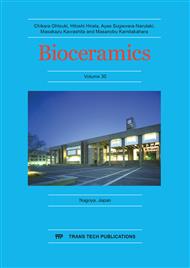[1]
A.H. Borges, F.L.M. Pedro, C.E.S. Miranda, A. Semeno - Segundo, J.D. Pe ́cora, and A.M.C. Filho, Comparative study of physico-chemical properties of mta-based and portland cements, Acta Odontol Latinoam. 23 (2010) 175–181.
Google Scholar
[2]
C. Estrela, L.L. Bammann, C.R. Estrela, R.S. Silva, and J.D. Pe ́cora, Antimicrobial and chemical study of mta, portland cement, calcium hydroxide paste, sealapex and dycal, Braz. Dent. J. 11 (2000) 3–9.
Google Scholar
[3]
J. Camilleri and T.R.P. Ford, Mineral trioxide aggregate: a review of the constituents and biological properties of the material, Int. Endod. J. 39 (2006) 747–754.
DOI: 10.1111/j.1365-2591.2006.01135.x
Google Scholar
[4]
J.D.S. Neto, T.B. Schnaider, A. Gragnani, A.P. de Paiva, N.F. Novo, and L.M. Ferreira, Portland cement with additives in the repair of furcation perforations in dogs, Acta Cir. Bras. 27 (2012) 809–814.
DOI: 10.1590/s0102-86502012001100011
Google Scholar
[5]
L. Qiu, J.C. Nicola. The hydration chemistry of proroot mta, Dent. Mater. J. 34 (2015) 458-465.
Google Scholar
[6]
P. Taddei, E. Modena, A. Tinti, F. Siboni, C. Prati, and M.G. Gandolfi, Vibrational investigation of calcium-silicate cements for endodontics in simulated body fluids, J. Mol. Struc. 993 (2011) 367–375.
DOI: 10.1016/j.molstruc.2010.12.058
Google Scholar
[7]
L. Radev, V. Hristov, I. Michailova, H.M.V. Fernandes, and M.I.M. Salvado, In vitro bioactivity of biphasic calcium phosphate silicate glass-ceramic in CaO-SiO2-P2O5 system, Processing and Application of Ceramics. 4 (2010) 15–24.
DOI: 10.2298/pac1001015r
Google Scholar
[8]
J. Bensted, S.P. Varma. Some applications of infrared and raman spectroscopy in cement chemistry: hydration of portland cement and its constituents, Cem. Technol. 5 (1974) 440-450.
Google Scholar
[9]
B.C. Liga and B. Natalija, Research of calcium phosphates using fourier transform infrared spectroscopy, Intech Open Access Pub., (2012).
Google Scholar
[10]
M.L. Franquelo, A. Duran, L.K. Herrera, M.C.J. deHaro, and J.L. Perez-Rodriguez, Comparison between micro-Raman and micro-ftir spectroscopy techniques for the characterization of pigments from southern spain cultural heritage, J. Mol. Struc. 924 (2009).
DOI: 10.1016/j.molstruc.2008.11.041
Google Scholar
[11]
E.J. Garboczi and J.W. Bullard, Shape analysis of a reference cement, Cement and Concrete Research. 34 (2004) 1933–(1937).
DOI: 10.1016/j.cemconres.2004.01.006
Google Scholar
[12]
K.S. Coomaraswamy, P.J. Lumley, and M.P. Hofmann, Effect of bismuth oxide radioopacifer content on the material properties of an endodontic portland cement-based (mta-like) system, J. Endod. 33 (2007) 295–298.
DOI: 10.1016/j.joen.2006.11.018
Google Scholar
[13]
J. Camilleri, A. Cutajar, and B. Mallia, Hydration characteristics of zirconium oxide replaced portland cement for use as a root-end filling material, Dent. Mater. J. 27 (2011) 845–854.
DOI: 10.1016/j.dental.2011.04.011
Google Scholar
[14]
S.W. Chang, S.H. Baek, H.C. Yang et al., Heavy metal analysis of ortho mta and proroot mta, J. Endod. 37 (2011)1673–1676.
DOI: 10.1016/j.joen.2011.08.020
Google Scholar
[15]
J.J.R.F. Silva and R.J.P. Williams, The biological chemistry of the elements: the inorganic chemistry of life, 2nd ed., Oxford, UK, (2001).
Google Scholar
[16]
C. Estrela, M.D. Sousa-Neto, O.A. Guedes, A.H.G. Alencar, M.A.H. Duarte, and J.D. Pe ́cora, Characterization of calcium oxide in root perforation sealer materials, Braz. Dent. J. 23 (2012) 539–546.
DOI: 10.1590/s0103-64402012000500012
Google Scholar
[17]
S.W. Chang, W.J. Shon, W. Lee, K.Y. Kum, S.H. Baek, and K.S. Bae, Analysis of heavy metal contents in gray and white mta and two kinds of portland cement: a preliminary study, Oral surg. Oral Med. Oral Pathol. Oral Radiol. Endod. 109 (2010).
DOI: 10.1016/j.tripleo.2009.12.017
Google Scholar
[18]
G.D. Pecharki, J.A. Cury, A.F. Paes Leme, C.P. Tabchoury, A.A Del Bel Cury, P.L. Rosalen, W.H. Bowen. Effect of sucrose containing iron (II) on dental biofilm and enamel demineralization in situ, Caries Res. 39 (2005) 123.
DOI: 10.1159/000083157
Google Scholar
[19]
A.R. Eshghi, R. Koswari-Isfahan, M. Rezaiefer, M. Razavi, and S. Zeighami. Effect of iron containing supplements on rats' dental caries progression, J. Dent. 9 (2012) 14–19.
Google Scholar
[20]
International Standardization Organization 9917-1, Dentistry: water-based cements-part 1: powder/liquid acid-base cements, International Standardization Organization, Geneva, Switzerland, (2007).
DOI: 10.3403/30169263
Google Scholar
[21]
M.A.H. Duarte, A.C. deOliveira Demarchi, J.C. Yamashita, M.C. Kuga, and S. De Campos Fraga, Arsenic release provided by mta and portland cement, Oral surg. Oral Med. Oral Pathol. Oral Radiol. Endod. 99 (2005) 648–650.
DOI: 10.1016/j.tripleo.2004.09.015
Google Scholar
[22]
J. Camilleri, The physical properties of accelerated portland cement for endodontic use, Int. Endod. J. 41 (2008) 151–157.
DOI: 10.1111/j.1365-2591.2007.01330.x
Google Scholar
[23]
M. Tanomaru, R. Viapiana, J. Guerreiro, From mta to new biomaterials based on calcium silicate. Int. J. Dental Sc. 18-1 (2016) 18-22.
DOI: 10.15517/ijds.v18i1.23483
Google Scholar
[24]
T. Dammaschke, H.U. Gerth, H. Zachner, and E. Schafer, Chemical and physical surface and bulk material characterization of white proroot mta and two portland cements. Dent. Mater. J. 21 (2005) 731–738.
DOI: 10.1016/j.dental.2005.01.019
Google Scholar


